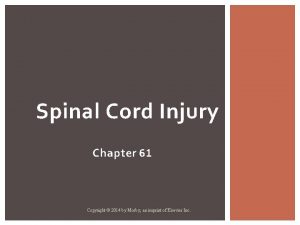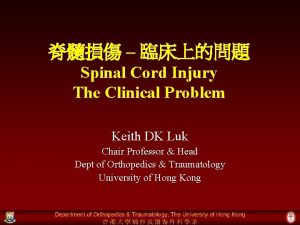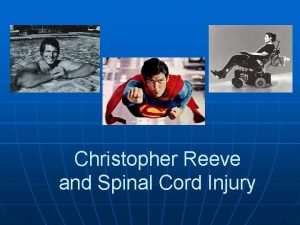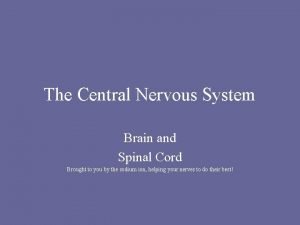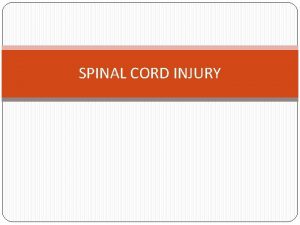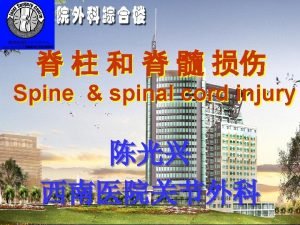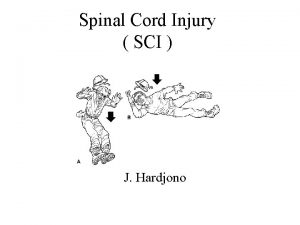SPINAL CORD INJURY What is the spinal cord











- Slides: 11

SPINAL CORD INJURY What is the spinal cord? What happens when a spinal cord is injured? What’s an incomplete SCI? Why is level of injury important? Fast Facts

What is the spinal cord? � The spinal cord is a thick bundle of nerves that runs through the vertebrae (backbones) in your spine. This nerve bundle is about 18 inches long, starting at the base of your brain and ending at your buttocks. The spinal cord acts as a superhighway between your brain and the rest of your body. Want to take a step, or wriggle a finger? The message is normally sent through the spinal cord to these body parts, in the form of nerve impulses. The highway runs in both directions: stub a toe or touch something sharp, and those pain or pressure signals speed back up to your brain faster than you can say “ow. ”

What happens when a spinal cord is injured? � An accident that causes your vertebrae to break can also damage your spinal cord. And when the spinal cord is damaged, the highway is essentially closed. Nerve impulses can’t get through. This results in paralysis – loss of mobility and sensation – below the level of injury.

What’s an incomplete SCI? � Not all spinal cord injuries cause complete paralysis. In the case of an incomplete spinal cord injury, a small stream of highway traffic still gets through. Someone with an incomplete SCI may have a certain amount of feeling or movement below the level of injury. Often, in the case of an incomplete SCI, one side of the body has more function than the other. Thanks to new medical treatments at the time of injury, incomplete spinal cord injuries are more common than they used to be. These same injuries might have been complete if they’d happened a couple of decades earlier.

Why is level of injury important? � The site of your injury will determine what parts of your body are paralyzed. The higher the injury, the more body parts that are affected. For instance, a spinal cord injury in the upper, or cervical, region of your spine will affect your arms as well as your trunk, legs and pelvic area (including bowel and bladder). Someone with this level of injury is considered to be quadriplegic. But an injury lower down, in the thoracic or lumbar region, won’t affect your arms. Someone with a spinal cord injury in either of these regions is considered to be paraplegic. About half of all people with SCI are quadriplegic, and half are paraplegic.

Fast Facts �A spinal cord injury can happen to anyone at any time. � There are 600 new spinal cord injuries every year in Ontario (more than one a day) and current estimates indicate that there approximately 33, 140 Ontarians living with spinal cord injury. (Urban Futures Institute Report, 2010) � In Canada there are more than 1, 500 new spinal cord injuries per year. There is an estimated 86, 000 people living in the country with spinal cord injuries. (#s based on research by the Urban Futures Institute, 2010)

. . . More Fast Facts. . . � Spinal cord injury is one of the most traumatic events to occur in an individual’s life. � Spinal cord injury affects family, friends, employers, community and the health care system. � People can, and do, make a positive adjustment to life with a spinal cord injury given the right supports at the right time. � On average, it takes 2 to 3 years to attain sufficient independence following a spinal cord injury.

. . . and even more Fast Facts. . . � Intensive psycho-social support is a critical component to rehabilitation from the onset of injury, through acute hospitalization, rehabilitation and transition to community living. � It is estimated that the annual economic burden of traumatic SCI in Canada is approximately $3. 6 billion, of which $1. 8 billion is associated with direct health care costs. (Urban Futures Institute Report, 2010)

Some statistics � The top causes for traumatic spinal cord injuries in Ontario are: ◦ unintentional falls – 43. 2% ◦ motor vehicle accidents – 42. 8 � In Ontario, males represent 68. 4% of traumatic spinal cord injuries. Women represent 31. 6%. � In Ontario, the highest incidence of traumatic injury is to individuals in the age range of 20 -29 and to also, those over 70 years of age. � Problems related to pain, mobility and agility affected the largest number of adults. Nearly 3 million adults aged 15 and over, or 11% of this age group, reported one of these limitations. (PALS 2006)

Some more stats � Disabilities related to mobility were present in less than 2% of people between the ages of 15 and 24, but affected about 44% of individuals aged 75 and over. (PALS 2006) � Ontario reported a disability rate (15. 5%) slightly higher than the national rate. (PALS 2006) � It is estimated that 90% of what we know about spinal cord injury has been discovered in the last 20 years. (Rick Hansen Institute)

Sports and SCI’s � � � Interested in getting back in the game? Sports like basketball, rugby, hockey and tennis have all been adapted for people who use wheelchairs. Check out these links to wheelchair sport organizations in Ontario. Canadian Wheelchair Sports Association http: //www. cwsa. ca Ontario Wheelchair Sports Associationhttp: //www. ontwheelchairsports. org Spitfires Wheelchair Sports Association Ontariohttp: //www. spitfirechallenge. ca National Capital Sports Council of the Disabled http: //www. ncscd. ca National Capital Wheelchair Tennis Associationhttp: //www. magma. ca/~ncwta Canadian Electric Wheelchair Hockey Associationhttp: //www. geocities. com/cewha Canadian Association for Disabled Skiing – Ontariohttp: //www. disabledskiingontario. com Canadian Paralympic Committee http: //www. paralympic. ca And just for fun…Heard about Murderball? This award-winning movie about the fast and furious sport of wheelchair rugby? Check the sport out : http: //www. youtube. com/watch? v=Ti. C 9 O 76 Uo. Lc
 Somi brace
Somi brace Spinal cord injury protocol
Spinal cord injury protocol Spinal cord injury shoulder exercises
Spinal cord injury shoulder exercises Christopher reeve spinal cord injury level
Christopher reeve spinal cord injury level Spinal cord injury rehabilitation st. louis
Spinal cord injury rehabilitation st. louis Eat well live well with spinal cord injury
Eat well live well with spinal cord injury Ligamentum denticulatum
Ligamentum denticulatum On occasion our trusty truck acts funny
On occasion our trusty truck acts funny Figure 13-2 spinal nerves
Figure 13-2 spinal nerves Median nerve innervates
Median nerve innervates Intentional injury examples
Intentional injury examples Nervous sysytem
Nervous sysytem
